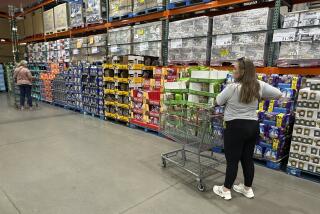Manufacturing Slides 0.8%, Stifling Hopes for Recovery
- Share via
WASHINGTON — Industrial activity plunged in August, extending what is now the longest decline in factory output in three decades. The discouraging economic news intensified fears that the ailing economy--shaken by the worst terrorist attack in U.S. history--could tip into recession.
The Federal Reserve reported Friday that industrial production fell by 0.8% last month, the 11th consecutive monthly decline, stifling hopes that manufacturers were about to turn a corner. Many economists had thought that July’s tiny 0.1% drop in output might be signaling better days ahead.
“The manufacturing sector was in full retreat as we entered September and recent events will only make things worse,” said Joel Naroff of Naroff Economic Advisors. “Conditions are still disastrous.”
Optimism that the country will be able to mount a sustained recovery in the second half of this year had already been dealt a blow by this week’s attacks in New York and Washington, which brought a temporary halt to airline travel, shut down the stock exchanges and disrupted business nationwide.
“For the foreseeable future, the economy is clearly going to be weaker,” said Sung Won Sohn, chief economist at Wells Fargo.
In other economic reports, retail sales rose modestly while wholesale prices rose as the cost of gasoline and other energy products jumped.
The producer price index, a closely watched gauge of inflation, rose 0.4% in August after falling 0.9% in July, the Labor Department said. However, the core rate of inflation, which excludes the volatile food and energy components, fell 0.1%, the first decline since February.
Retail sales rose 0.3% last month, the biggest increase since April, despite the fact that auto sales fell. Excluding autos, sales posted a gain of 0.5%.
The 0.8% drop in industrial production brought the string of declines to 11, the longest stretch of weakness in more than three decades, since an 11-month fall from February through December 1960.
The manufacturing sector, hardest hit by the yearlong slowdown in economic activity, has throttled back production and slashed more than 1 million workers.
Despite rising unemployment, the nation has been kept out of a recession because consumers have continued to buy homes, cars and other big-ticket items. However, analysts are now worried that the attacks could cause consumers to stop spending, knocking the one remaining prop out from under the economy and pushing the country into recession.
The weakness in industrial output in August was led by sizable decreases in production of autos and auto products and various consumer goods. Information processing equipment, a category that includes computers, was down 0.5% in August after an even larger 1.6% drop in July.
The declines in production left U.S. industry operating at just 76.2% of capacity in August, the weakest performance since July 1983.
The strength in retail sales last month was led by a 1.4% increase in sales at gasoline stations. But sales at department stores and restaurants rose, offsetting a 0.2% drop in car sales.
More to Read
Inside the business of entertainment
The Wide Shot brings you news, analysis and insights on everything from streaming wars to production — and what it all means for the future.
You may occasionally receive promotional content from the Los Angeles Times.










